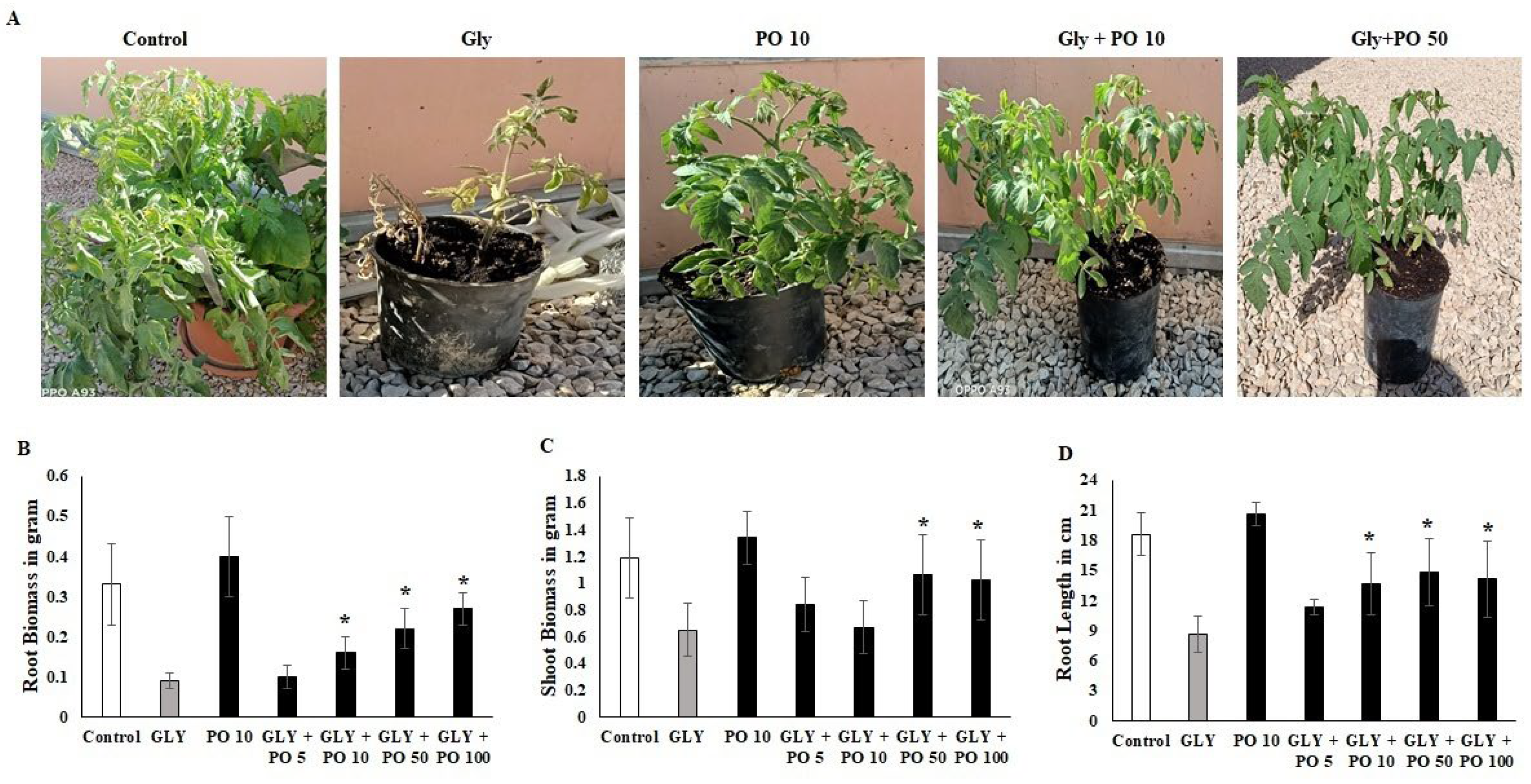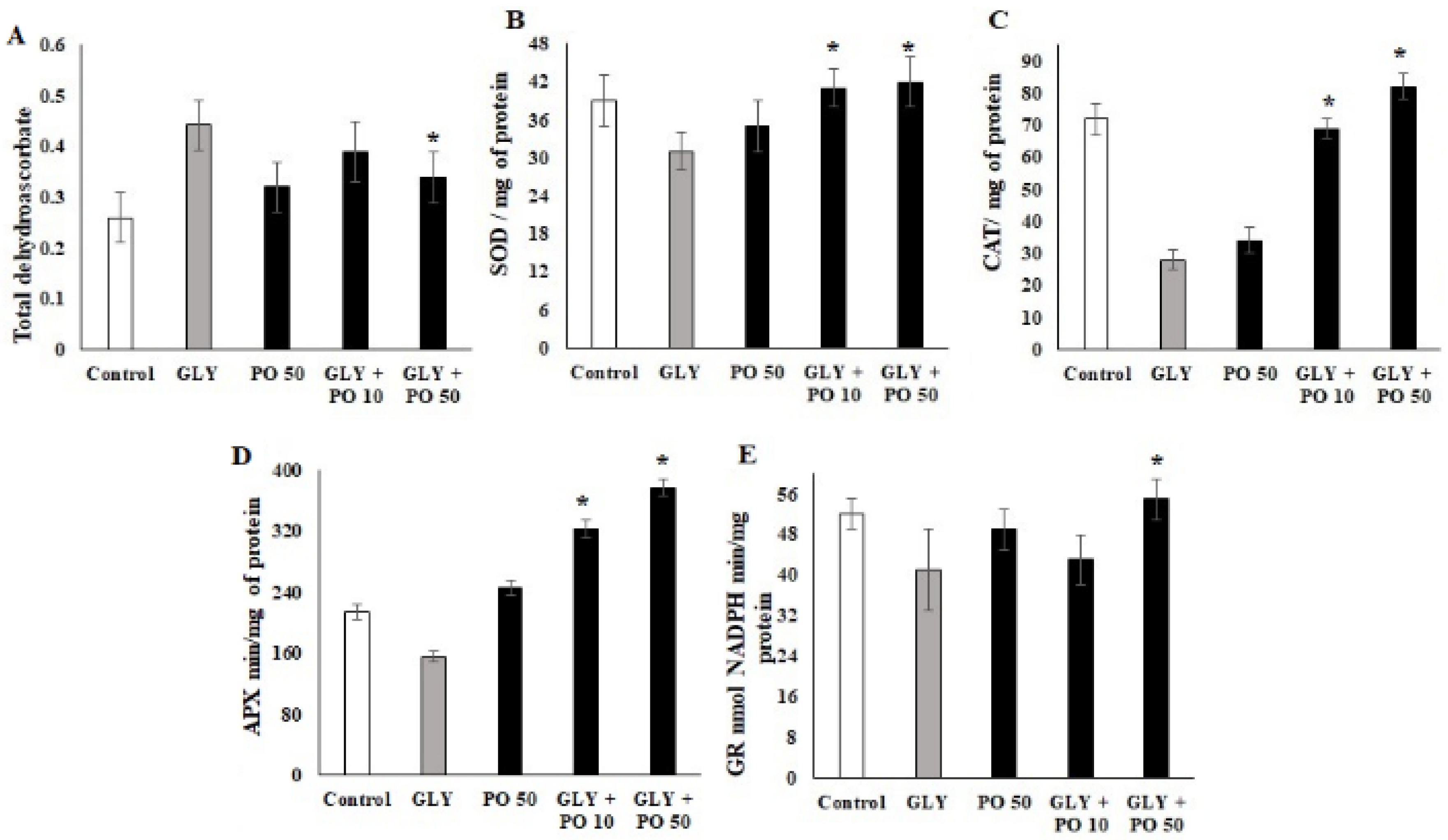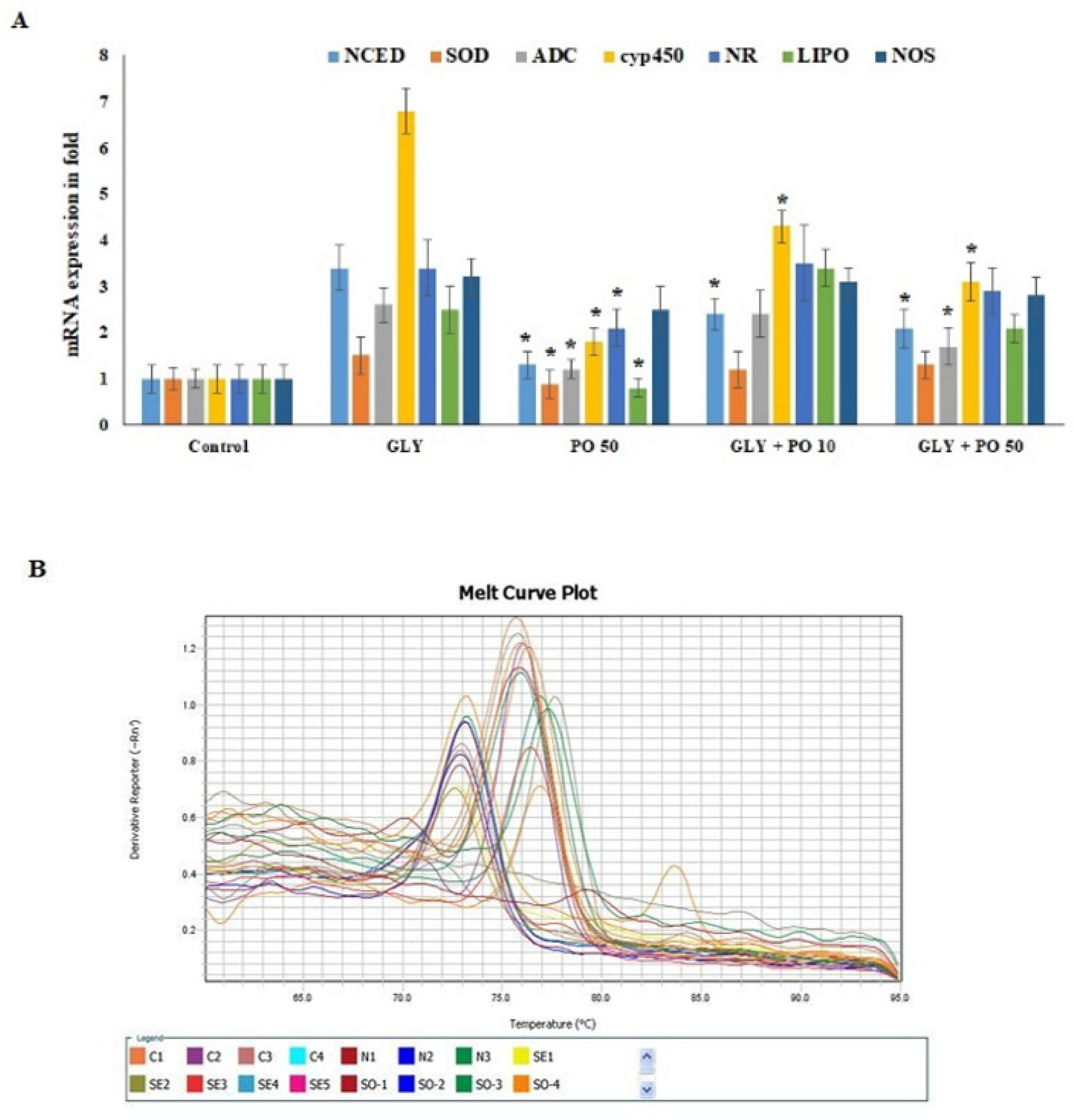Alleviation of Herbicide Toxicity in Solanum lycopersicum L.—An Antioxidant Stimulation Approach
Abstract
:1. Introduction
2. Results
2.1. Root Biomass Estimation
2.2. Shoot Biomass Estimation
2.3. Root Length Estimation
2.4. Estimation of MDA, H2O2 and O2
2.5. Quantification of Non-Enzymatic Markers
2.6. Quantification of Enzymatic Markers
2.7. Effect of PO on Antioxidant and Metabolic mRNA Markers in S. lycopersicum
3. Discussion
4. Materials and Methods
4.1. Plant Material and Growth Conditions
4.2. Experimental Design
- Control; plants grown in OECD substrate (negative control).
- GLY; plants grown in OECD substrate contaminated with sub-lethal dose of 10 mg kg−1 GLY (positive herbicide control).
- PO 10; plants grown in OECD substrate treated once a week with 10 mM pongamia oil by foliar spraying (positive oil control).
- GLY + PO 5; plants grown in OECD substrate contaminated with sub-lethal dose of 10 mg kg−1 GLY and treated once a week with 5 mM pongamia oil by foliar spraying. This was later omitted, because the results were not significant from GLY + PO 10.
- GLY + PO 10; plants grown in OECD substrate contaminated with sub-lethal dose of 10 mg kg−1 GLY and treated once a week with 10 mM pongamia oil by foliar spraying.
- GLY + PO 50; plants grown in OECD substrate contaminated with sub-lethal dose of 10 mg kg−1 GLY and treated once a week with 50 mM pongamia oil by foliar spraying.
- GLY + PO 100; plants grown in OECD substrate contaminated with sub-lethal dose of 10 mg kg−1 GLY and treated once a week with 100 mM pongamia oil by foliar spraying. This was later omitted, because the results were not significant from GLY + PO 50.
4.3. Quantification of Non-Enzymatic Antioxidants—Proline (Pro), Glutathione (GSH), Ascorbate (AsA) and Total Ascorbic Acid
4.4. Measurement of Physiological Indexes of Enzymatic Antioxidants
4.5. H2O2 and Malondialdehyde (MDA) Content
4.6. Estimation of O2 (ROS) Level in Shoot and Root of Tomato
4.7. Gene Expression
4.8. Statistics
5. Conclusions
Author Contributions
Funding
Institutional Review Board Statement
Informed Consent Statement
Data Availability Statement
Acknowledgments
Conflicts of Interest
References
- Gianessi, L.P. The Increasing Importance of Herbicides in Worldwide Crop Production. Pest Manag. Sci. 2013, 69, 1099–1105. [Google Scholar] [CrossRef] [PubMed]
- Martins-Gomes, C.; Silva, T.L.; Andreani, T.; Silva, A.M. Glyphosate vs. Glyphosate-Based Herbicides Exposure: A Review on Their Toxicity. J. Xenobiotics 2022, 12, 21–40. [Google Scholar] [CrossRef] [PubMed]
- Singh, S.; Kumar, V.; Gill, J.P.K.; Datta, S.; Singh, S.; Dhaka, V.; Kapoor, D.; Wani, A.B.; Dhanjal, D.S.; Kumar, M.; et al. Herbicide Glyphosate: Toxicity and Microbial Degradation. Int. J. Environ. Res. Public Health 2020, 17, 7519. [Google Scholar] [CrossRef] [PubMed]
- Siehl (19) (PDF) Inhibitors of EPSP Synthase, Glutamine Synthetase and Histidine Synthesis. Available online: https://www.researchgate.net/publication/292667029_Inhibitors_of_EPSP_synthase_glutamine_synthetase_and_histidine_synthesis (accessed on 2 June 2022).
- Duke, S.O.; Lydon, J.; Koskinen, W.C.; Moorman, T.B.; Chaney, R.L.; Hammerschmidt, R. Glyphosate Effects on Plant Mineral Nutrition, Crop Rhizosphere Microbiota, and Plant Disease in Glyphosate-Resistant Crops. J. Agric. Food Chem. 2012, 60, 10375–10397. [Google Scholar] [CrossRef]
- Gomes, M.P.; Smedbol, E.; Chalifour, A.; Hénault-Ethier, L.; Labrecque, M.; Lepage, L.; Lucotte, M.; Juneau, P. Alteration of Plant Physiology by Glyphosate and Its By-Product Aminomethylphosphonic Acid: An Overview. J. Exp. Bot. 2014, 65, 4691–4703. [Google Scholar] [CrossRef]
- Duke, S.O. The History and Current Status of Glyphosate. Pest Manag. Sci. 2018, 74, 1027–1034. [Google Scholar] [CrossRef]
- Heap, I. Global Perspective of Herbicide-Resistant Weeds. Pest Manag. Sci. 2014, 70, 1306–1315. [Google Scholar] [CrossRef]
- Heap, I.; Duke, S.O. Overview of Glyphosate-Resistant Weeds Worldwide. Pest Manag. Sci. 2018, 74, 1040–1049. [Google Scholar] [CrossRef]
- Sammons, R.D.; Gaines, T.A. Glyphosate Resistance: State of Knowledge. Pest Manag. Sci. 2014, 70, 1367–1377. [Google Scholar] [CrossRef]
- Green, J.M. The Rise and Future of Glyphosate and Glyphosate-Resistant Crops. Pest Manag. Sci. 2018, 74, 1035–1039. [Google Scholar] [CrossRef]
- Soares, C.; Nadais, P.; Sousa, B.; Pinto, E.; Ferreira, I.M.P.L.V.O.; Pereira, R.; Fidalgo, F. Silicon Improves the Redox Homeostasis to Alleviate Glyphosate Toxicity in Tomato Plants—Are Nanomaterials Relevant? Antioxidants 2021, 10, 1320. [Google Scholar] [CrossRef]
- Pall, A. Mitigation of Glyphosate-Induced Plant Stress in Soybean Using Salicylic Acid. Master’s Thesis, McGill University, Montreal, QC, Canada, August 2019. [Google Scholar]
- Shahid, M.; Khan, M.S. Glyphosate Induced Toxicity to Chickpea Plants and Stress Alleviation by Herbicide Tolerant Phosphate Solubilizing Burkholderia Cepacia PSBB1 Carrying Multifarious Plant Growth Promoting Activities. 3 Biotech 2018, 8, 1–17. [Google Scholar] [CrossRef] [PubMed]
- Kutman, B.Y.; Kutman, U.B.; Cakmak, I. Foliar Nickel Application Alleviates Detrimental Effects of Glyphosate Drift on Yield and Seed Quality of Wheat. J. Agric. Food Chem. 2013, 61, 8364–8372. [Google Scholar] [CrossRef]
- Plaola, Y.; Leangsiri, W.; Pongsiriyakul, K.; Kiatkittipong, W.; Srifa, A.; Lim, J.W.; Reubroycharoen, P.; Kiatkittipong, K.; Eiad-Ua, A.; Assabumrungrat, S. Catalytic Hydrotreating of Crude Pongamia Pinnata Oil to Bio-Hydrogenated Diesel over Sulfided NiMo Catalyst. Energies 2022, 15, 1547. [Google Scholar] [CrossRef]
- Sarin, A.; Arora, R.; Singh, N.P.; Sarin, R.; Sharma, M.; Malhotra, R.K. Effect of Metal Contaminants and Antioxidants on the Oxidation Stability of the Methyl Ester of Pongamia. JAOCS J. Am. Oil Chem. Soc. 2010, 87, 567–572. [Google Scholar] [CrossRef]
- Purkait, A.; Mukherjee, A.; Hazra, D.K.; Roy, K.; Biswas, P.K.; Kole, R.K. Encapsulation, Release and Insecticidal Activity of Pongamia Pinnata (L.) Seed Oil. Heliyon 2021, 7, e06557. [Google Scholar] [CrossRef] [PubMed]
- Chaturvedi, S.; Kumar, V.; Satya, S. Composting Effects of Pongamia Pinnata on Tomato Fertilization. Arch. Agron. Soil Sci. 2009, 55, 535–546. [Google Scholar] [CrossRef]
- Rajput, M.; Bithel, N.; Vijayakumar, S. Antimicrobial, Antibiofilm, Antioxidant, Anticancer, and Phytochemical Composition of the Seed Extract of Pongamia Pinnata. Arch. Microbiol. 2021, 203, 4005–4024. [Google Scholar] [CrossRef]
- Jahan, S.; Mahmud, M.H.; Khan, Z.; Alam, A.; Khalil, A.A.; Rauf, A.; Tareq, A.M.; Nainu, F.; Tareq, S.M.; Emran, T.B.; et al. Health Promoting Benefits of Pongamol: An Overview. Biomed. Pharmacother. 2021, 142, 112109. [Google Scholar] [CrossRef]
- de Freitas-Silva, L.; de Araújo, T.O.; Nunes-Nesi, A.; Ribeiro, C.; Costa, A.C.; da Silva, L.C. Evaluation of Morphological and Metabolic Responses to Glyphosate Exposure in Two Neotropical Plant Species. Ecol. Indic. 2020, 113, 106246. [Google Scholar] [CrossRef]
- Cakmak, I.; Yazici, A.; Tutus, Y.; Ozturk, L. Glyphosate Reduced Seed and Leaf Concentrations of Calcium, Manganese, Magnesium, and Iron in Non-Glyphosate Resistant Soybean. Eur. J. Agron. 2009, 31, 114–119. [Google Scholar] [CrossRef]
- Mateos-Naranjo, E.; Redondo-Gómez, S.; Cox, L.; Cornejo, J.; Figueroa, M.E. Effectiveness of Glyphosate and Imazamox on the Control of the Invasive Cordgrass Spartina Densiflora. Ecotoxicol. Environ. Saf. 2009, 72, 1694–1700. [Google Scholar] [CrossRef] [PubMed]
- Huang, J.; Silva, E.N.; Shen, Z.; Jiang, B.; Lu, H. Effects of Glyphosate on Photosynthesis, Chlorophyll Fluorescence and Physicochemical Propertiesof Cogongrass (Imperata Cylindrical L.). Plant Omics 2012, 5, 177–183. [Google Scholar]
- Zobiole, L.H.S.; Kremer, R.J.; de Oliveira, R.S., Jr.; Constantin, J. Glyphosate Effects on Photosynthesis, Nutrient Accumulation, and Nodulation in Glyphosate-Resistant Soybean. J. Plant Nutr. Soil Sci 2012, 175, 319–330. [Google Scholar] [CrossRef]
- Gomes, M.P.; Le Manac’h, S.G.; Hénault-Ethier, L.; Labrecque, M.; Lucotte, M.; Juneau, P. Glyphosate-Dependent Inhibition of Photosynthesis in Willow. Front. Plant Sci. 2017, 8, 1–13. [Google Scholar] [CrossRef] [PubMed]
- Ding, W.; Reddy, K.N.; Zablotowicz, R.M.; Bellaloui, N.; Bruns, H.A. Physiological Responses of Glyphosate-Resistant and Glyphosate-Sensitive Soybean to Aminomethylphosphonic Acid, a Metabolite of Glyphosate. Chemosphere 2011, 83, 593–598. [Google Scholar] [CrossRef]
- Zablotowicz, R.M.; Reddy, K.N. Nitrogenase Activity, Nitrogen Content, and Yield Responses to Glyphosate in Glyphosate-Resistant Soybean. Crop Prot. 2007, 26, 370–376. [Google Scholar] [CrossRef]
- Bellaloui, N.; Zablotowicz, R.M.; Reddy, K.N.; Abel, C.A. Nitrogen Metabolism and Seed Composition as Influenced by Glyphosate Application in Glyphosate-Resistant Soybean. J. Agric. Food Chem. 2008, 56, 2765–2772. [Google Scholar] [CrossRef]
- Zablotowicz, R.M.; Reddy, K.N. Impact of Glyphosate on the Bradyrhizobium Japonicum Symbiosis with Glyphosate-Resistant Transgenic Soybean: A Minireview. J. Environ. Qual. 2004, 33, 825–831. [Google Scholar] [CrossRef]
- Eker, S.; Ozturk, L.; Yazici, A.; Erenoglu, B.; Romheld, V.; Cakmak, I. Foliar-Applied Glyphosate Substantially Reduced Uptake and Transport of Iron and Manganese in Sunflower (Helianthus Annuus L.) Plants. J. Agric. Food Chem. 2006, 54, 10019–10025. [Google Scholar] [CrossRef]
- Su, Y.S.; Ozturk, L.; Cakmak, I.; Budak, H. Turfgrass Species Response Exposed to Increasing Rates of Glyphosate Application. Eur. J. Agron. 2009, 31, 120–125. [Google Scholar] [CrossRef] [Green Version]
- Jiang, L.X.; Jin, L.G.; Guo, Y.; Tao, B.; Qiu, L.J. Glyphosate Effects on the Gene Expression of the Apical Bud in Soybean (Glycine Max). Biochem. Biophys. Res. Commun. 2013, 437, 544–549. [Google Scholar] [CrossRef] [PubMed]
- Matschke, J.; Macháčková, I. Changes in the Content of Indole-3-Acetic Acid and Cytokinins in Spruce, Fir and Oak Trees after Herbicide Treatment. Biol. Plant. 2002, 45, 375–382. [Google Scholar] [CrossRef]
- Kremer, R.J.; Means, N.E. Glyphosate and Glyphosate-Resistant Crop Interactions with Rhizosphere Microorganisms. Eur. J. Agron. 2009, 31, 153–161. [Google Scholar] [CrossRef]
- Sergiev, I.G.; Alexieva, V.S.; Ivanov, S.V.; Moskova, I.I.; Karanov, E.N. The Phenylurea Cytokinin 4PU-30 Protects Maize Plants against Glyphosate Action. Pestic. Biochem. Physiol. 2006, 85, 139–146. [Google Scholar] [CrossRef]
- Lee, T.T.; Dumas, T. Effect of Glyphosate on Ethylene Production in Tobacco Callus. Plant Physiol. 1983, 72, 855–857. [Google Scholar] [CrossRef]
- Fernandes, B.; Soares, C.; Braga, C.; Rebotim, A.; Ferreira, R.; Ferreira, J.; Fidalgo, F.; Pereira, R.; Cachada, A. Ecotoxicological Assessment of a Glyphosate-Based Herbicide in Cover Plants: Medicago Sativa L. as a Model Species. Appl. Sci. 2020, 10, 5098. [Google Scholar] [CrossRef]
- Wang, J.; Xie, H.; Han, J.; Li, J.; Lin, X.; Wang, X. Effect of Graphene Oxide-Glyphosate Nanocomposite on Wheat and Rape Seedlings: Growth, Photosynthesis Performance, and Oxidative Stress Response. Environ. Technol. Innov. 2022, 27, 102527. [Google Scholar] [CrossRef]
- Caverzan, A.; Piasecki, C.; Chavarria, G.; Stewart, C.N.; Vargas, L. Defenses against ROS in Crops and Weeds: The Effects of Interference and Herbicides. Int. J. Mol. Sci. 2019, 20, 1086. [Google Scholar] [CrossRef]
- Gunes, A.; Inal, A.; Bagci, E.G.; Coban, S.; Pilbeam, D.J. Silicon Mediates Changes to Some Physiological and Enzymatic Parameters Symptomatic for Oxidative Stress in Spinach (Spinacia Oleracea L.) Grown under B Toxicity. Sci. Hortic. 2007, 113, 113–119. [Google Scholar] [CrossRef]
- Ahsan, N.; Lee, D.G.; Lee, K.W.; Alam, I.; Lee, S.H.; Bahk, J.D.; Lee, B.H. Glyphosate-Induced Oxidative Stress in Rice Leaves Revealed by Proteomic Approach. Plant Physiol. Biochem. 2008, 46, 1062–1070. [Google Scholar] [CrossRef] [PubMed]
- Serra, A.-A.; Nuttens, A.; Larvor, V.; Renault, D.; Couée, I.; Sulmon, C.; Gouesbet, G. Low Environmentally Relevant Levels of Bioactive Xenobiotics and Associated Degradation Products Cause Cryptic Perturbations of Metabolism and Molecular Stress Responses in Arabidopsis Thaliana. J. Exp. Bot. 2013, 64, 2753–2766. [Google Scholar] [CrossRef] [PubMed]
- Shopova, E.; Brankova, L.; Katerova, Z.; Dimitrova, L.; Todorova, D.; Sergiev, I.; Talaat, N.B. Salicylic Acid Pretreatment Modulates Wheat Responses to Glyphosate. Crops 2021, 1, 88–96. [Google Scholar] [CrossRef]
- El-Mergawi, R.A.; El-Dabaa, M.A.T. Aromatic Amino Acids Partially Alleviated Glyphosate Induced Effects on Metabolites and Growth in Faba Bean with a More Phytotoxicity in Orobanche Crenata Parasite. Egypt. J. Chem. 2021, 64, 4641–4652. [Google Scholar] [CrossRef]
- Soares, C.; Rodrigues, F.; Sousa, B.; Pinto, E.; Ferreira, I.M.P.L.V.O.; Pereira, R.; Fidalgo, F. Foliar Application of Sodium Nitroprusside Boosts Solanum Lycopersicum L. Tolerance to Glyphosate by Preventing Redox Disorders and Stimulating Herbicide Detoxification Pathways. Plants 2021, 10, 1862. [Google Scholar] [CrossRef]
- Miteva, L.P.E.; Ivanov, S.V.; Alexieva, V.S. Alterations in Glutathione Pool and Some Related Enzymes in Leaves and Roots of Pea Plants Treated with the Herbicide Glyphosate. Russ. J. Plant Physiol. 2010, 57, 131–136. [Google Scholar] [CrossRef]
- Kielak, E.; Sempruch, C.; Mioduszewska, H.; Klocek, J.; Leszczyński, B. Phytotoxicity of Roundup Ultra 360 SL in Aquatic Ecosystems: Biochemical Evaluation with Duckweed (Lemna Minor L.) as a Model Plant. Pestic. Biochem. Physiol. 2011, 99, 237–243. [Google Scholar] [CrossRef]
- Hatamleh, A.A.; Danish, M.; Al-Dosary, M.A.; El-Zaidy, M.; Ali, S. Physiological and Oxidative Stress Responses of Solanum Lycopersicum (L.) (Tomato) When Exposed to Different Chemical Pesticides. RSC Adv. 2022, 12, 7237–7252. [Google Scholar] [CrossRef]
- Marsh, H.V.; Evans, H.J.; Matrone, G. Investigations of the Role of Iron in Chlorophyll Metabolism. II. Effect of Iron Deficiency on Chlorophyll Synthesis. Plant Physiol. 1963, 38, 638–642. [Google Scholar] [CrossRef]
- Yadav, R.D.; Jain, S.K.; Alok, S.; Prajapati, S.K.; Verma, A. Pongamia Pinnata: An Overveiw. Int. J. Pharm. Sci. Res. 2011, 2, 494–500. [Google Scholar]
- Thakur, S.; Kaurav, H.; Chaudhary, G. Karanj (Pongamia Pinnata)—An Ayurvedic and Modern Overview. Asian J. Pharm. Clin. Res. 2021, 14, 14–21. [Google Scholar] [CrossRef]
- Pande, H.; Khan, L.H.; Varshney, V.K. Comparative Study on In-Vitro Antioxidant Activity of Pongamia Pinnata Leaves and Seeds. World Appl. Sci. J. 2014, 32, 1330–1333. [Google Scholar] [CrossRef]
- Mitra, A.G.; Mandal, S.; Das, P.; Dasgupta, S.; Mukhopadhyay, S.; Mukhopadhyay, A.; Banerjee, J.; Kar, M. Antioxidant and Free Radical Scavenging Properties of Seed Components of Pongamia Pinnata—A Comparative Study. Org. Med. Chem IJ 2018, 7, 1–5. [Google Scholar] [CrossRef]
- Gorinova, N.; Nedkovska, M.; Atanassov, A. Cytochrome P450 Monooxygenases as a Tool for Metabolizing of Herbicides in Plants. Biotechnol. Biotechnol. Equip. 2005, 19, 105–115. [Google Scholar] [CrossRef]
- Siminszky, B. Plant Cytochrome P450-Mediated Herbicide Metabolism. Phytochem. Rev. 2006, 5, 445–458. [Google Scholar] [CrossRef]
- Gillespie, K.M.; Ainsworth, E.A. Measurement of Reduced, Oxidized and Total Ascorbate Content in Plants. Nat. Protoc. 2007, 2, 871–874. [Google Scholar] [CrossRef]
- Ekinci, M.; Ors, S.; Yildirim, E.; Turan, M.; Sahin, U.; Dursun, A.; Kul, R. Determination of Physiological Indices and Some Antioxidant Enzymes of Chard Exposed to Nitric Oxide under Drought Stress. Russ. J. Plant Physiol. 2020, 67, 740–749. [Google Scholar] [CrossRef]
- Sairam, R.K.; Rao, K.; Srivastava, G.C. Differential Response of Wheat Genotypes to Long Term Salinity Stress in Relation to Oxidative Stress, Antioxidant Activity and Osmolyte Concentration. Plant Sci. 2002, 163, 1037–1046. [Google Scholar] [CrossRef]
- Donahue, J.L.; Okpodu, C.M.; Cramer, C.L.; Grabau, E.A.; Alscher, R.G. Responses of Antioxidants to Paraquat in Pea Leaves (Relationships to Resistance). Plant Physiol. 1997, 113, 249–257. [Google Scholar] [CrossRef]
- Murshed, R.; Lopez-Lauri, F.; Sallanon, H. Microplate Quantification of Enzymes of the Plant Ascorbate-Glutathione Cycle. Anal. Biochem. 2008, 383, 320–322. [Google Scholar] [CrossRef]
- Lee, H.-J.; Kim, Y.-S.; Deuk Jo, Y.; Ha, B.-K.; Sub Kim, D.; Kim, J.-B.; Kang, S.-Y.; Hoon Kim, S. Oxidative Stress and DNA Damage Induced by Gamma Irradiation in Korean Lawngrass (Zoysia Japonica Steud.). Eur. J. Hortic. Sci. 2016, 81, 303–309. [Google Scholar] [CrossRef]
- Signorelli, S.; Imparatta, C.; Rodríguez-Ruiz, M.; Borsani, O.; Corpas, F.J.; Monza, J. In Vivo and in Vitro Approaches Demonstrate Proline Is Not Directly Involved in the Protection against Superoxide, Nitric Oxide, Nitrogen Dioxide and Peroxynitrite. Funct. Plant Biol. 2016, 43, 870–879. [Google Scholar] [CrossRef] [PubMed]
- Kumar, S.; Huang, X.; Ji, Q.; Qayyum, A.; Zhou, K.; Ke, W.; Zhu, H.; Zhu, G. Influence of Blanching on the Gene Expression Profile of Phenylpropanoid, Flavonoid and Vitamin Biosynthesis, and Their Accumulation in Oenanthe Javanica. Antioxidants 2022, 11, 470. [Google Scholar] [CrossRef] [PubMed]





| Primer Name | Forward Sequence | Reverse Sequence | PCR Product (bp) |
|---|---|---|---|
| NCED | GAA CTT CGT CGT CAT TCC TG | CAT CTT TCG CGT ACT TAT CCA | 197 |
| SOD1 | ACC ACA ACC AGC ACT ACC AAT | GTC CAG GAG CAA GTC CAG TTA | 186 |
| ADC | TGC TTG AAG TGT CTC TTG | GAT TGC GGT CAT AAC ATA AG | 213 |
| CYP1A1450 | GGG ACA TTA TTC GGG AGA GG | GAT GAT GAA AGC CGA TGA CAG | 167 |
| NR | ATC ACC CAG AGA AGC CAA CA | GAG GGT CTC ATC GGT AGC TC | 224 |
| LIPO | GCC TCT CTT CTT GAT GGA | GTA GTG AGC CAC TTC TCC AA | 178 |
| NOS | GAG CTC CGT TAC ACA CAT CG | CGA CAC CGT CCA CAA AGA AT | 211 |
| Actin | GAG AAG CAC ATT CCC TGA AAG | AGA ACT CCA CCA TCA CCA CC | 203 |
Publisher’s Note: MDPI stays neutral with regard to jurisdictional claims in published maps and institutional affiliations. |
© 2022 by the authors. Licensee MDPI, Basel, Switzerland. This article is an open access article distributed under the terms and conditions of the Creative Commons Attribution (CC BY) license (https://creativecommons.org/licenses/by/4.0/).
Share and Cite
Ibrahim, R.I.H.; Alkhudairi, U.A.; Alhusayni, S.A.S. Alleviation of Herbicide Toxicity in Solanum lycopersicum L.—An Antioxidant Stimulation Approach. Plants 2022, 11, 2261. https://doi.org/10.3390/plants11172261
Ibrahim RIH, Alkhudairi UA, Alhusayni SAS. Alleviation of Herbicide Toxicity in Solanum lycopersicum L.—An Antioxidant Stimulation Approach. Plants. 2022; 11(17):2261. https://doi.org/10.3390/plants11172261
Chicago/Turabian StyleIbrahim, Rashid I. H., Ubai A. Alkhudairi, and Sultan A. S. Alhusayni. 2022. "Alleviation of Herbicide Toxicity in Solanum lycopersicum L.—An Antioxidant Stimulation Approach" Plants 11, no. 17: 2261. https://doi.org/10.3390/plants11172261




